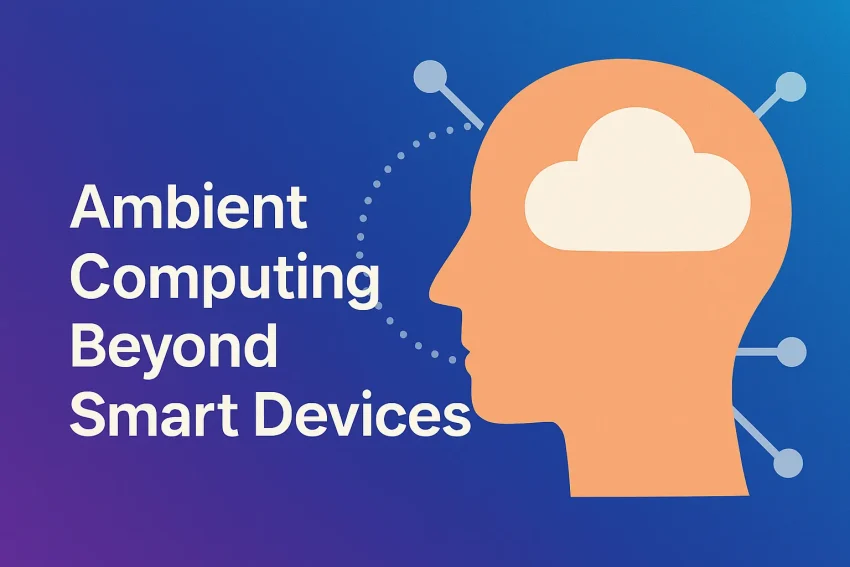Ambient Computing Beyond Smart Devices
As technology continues to evolve at an unprecedented pace, a new paradigm is quietly shaping the way we live, work, and interact: Ambient Computing. Often described as the seamless integration of digital services into everyday environments, ambient computing goes far beyond traditional smart devices. It represents a shift from user-initiated interaction to context-aware, intelligent systems that anticipate needs and operate in the background. This transformation is not just technical—it’s experiential.
What is Ambient Computing?
Ambient computing refers to a technology ecosystem where devices, sensors, AI, and software work together invisibly and proactively in the background of our lives. Unlike smartphones or tablets that require active engagement, ambient systems function passively, responding to human presence, behavior, and context.
These systems rely on:
- Sensors (motion, light, temperature, biometric, etc.)
- Artificial Intelligence and Machine Learning
- Edge Computing
- Internet of Things (IoT)
- Natural Language Processing and Voice Recognition
The goal is to create an environment where computing “fades into the background,” enhancing human experience rather than interrupting it.
The Evolution From Smart Devices
Smart devices such as thermostats, TVs, and watches were the first step toward contextual technology. However, they still require some level of interaction. Ambient computing minimizes or even eliminates this need, creating fully adaptive environments.
For example, while a smart light may respond to a mobile app or voice command, an ambient system will adjust lighting based on time of day, room occupancy, and even your mood—without you asking.
Key Features of Ambient Computing
1. Context Awareness
Ambient systems sense their surroundings and adapt behavior based on environmental and personal context (e.g., room temperature, user location, activity).
2. Pervasiveness
Devices and systems are embedded in everyday environments—homes, offices, cars—blending seamlessly with physical spaces.
3. Proactive Behavior
Rather than waiting for commands, ambient systems anticipate needs. For instance, a car may warm up before you enter during winter.
4. Low Friction Interfaces
These include voice, gesture, and facial recognition—interfaces that minimize conscious effort from users.
5. Privacy-First Architecture
Modern ambient computing emphasizes local data processing (edge computing) to enhance speed and protect user privacy.
Real-World Applications Beyond Smart Devices
1. Ambient Homes
Homes equipped with embedded sensors can:
- Adjust lighting and HVAC based on time, weather, and presence
- Monitor health markers like heart rate or sleep patterns
- Detect falls or emergencies in elderly care settings
2. Workplace Automation
Ambient systems in offices improve productivity by:
- Auto-adjusting lighting and temperature for comfort
- Notifying teams of meeting room availability
- Delivering personalized content or reminders
3. Healthcare Monitoring
In healthcare, ambient computing enables continuous, passive monitoring:
- Track patient vitals with no wearables
- Alert caregivers of anomalies in behavior
- Assist in mental health with mood-detection lighting and sound
4. Retail and Customer Experience
Retailers are using ambient technologies to:
- Offer real-time personalized promotions
- Automate checkout with facial recognition
- Manage stock via sensor-based shelf tracking
5. Smart Cities
Urban environments benefit from:
- Traffic flow regulation using environmental sensors
- Waste management optimization
- Public safety via crowd monitoring and adaptive lighting
The Role of AI and Machine Learning
Ambient computing depends heavily on AI to interpret context and machine learning to adapt over time. These systems must:
- Process vast datasets quickly
- Understand natural human language and behaviors
- Make probabilistic predictions to take proactive action
As models become more sophisticated, ambient environments will become more “intuitive,” learning from subtle cues like tone of voice, gait, or even body temperature.
Challenges to Ambient Computing
Despite its potential, several challenges must be addressed:
- Privacy and Surveillance: Continuous data collection raises ethical and legal concerns.
- Data Ownership: Users must know how their data is used and have control over it.
- Interoperability: Diverse hardware and platforms must work together.
- Cost and Accessibility: Implementation must be scalable and affordable.
Future Outlook
The next phase of ambient computing may include:
- Emotion-aware environments that adjust lighting or sound based on your feelings
- Brain-computer interfaces (BCIs) enabling thought-controlled environments
- Zero UI concepts where the interface is completely invisible
As ambient computing evolves, we will witness a shift from device-centric experiences to ecosystem-centric intelligence.
Ambient computing represents a quiet revolution. By embedding intelligence into everyday environments, it enhances user experience while minimizing cognitive load. Beyond smart devices, it offers a vision of the future where technology becomes truly human-centric—reactive, respectful, and reliably invisible.
To thrive in the ambient era, businesses and developers must focus not just on technology—but on experience design, ethics, and interoperability.
The future isn’t about more devices. It’s about less friction and more intuition.
#AmbientComputing #EdgeAI #SmartEnvironments #IoTInnovation #FutureTech









Ambient computing is taking us beyond screens and keyboards—into a world where technology becomes part of the environment itself. It’s exciting to imagine homes, workplaces, and even cities that respond intuitively to our needs.
Ambient computing is paving the way for a more intuitive tech experience. It’s not just about smart devices anymore—it’s about creating environments that respond to us naturally. This article does a great job highlighting that shift.
Great read! Ambient computing is transforming how we interact with technology—moving from active engagement to seamless, intuitive experiences. It’s exciting to think about how this will shape the future of our homes and workplaces.
Really enjoyed this piece! Ambient computing is clearly the next step in making technology feel more human and less intrusive. It’s amazing how invisible tech can enhance our daily routines so effortlessly.
Ambient computing is such a fascinating concept. Moving beyond just smart devices, it’s reshaping how we interact with technology in our daily lives—more seamless and intuitive than ever before.
Ambient computing is truly the next frontier of technology, making our interactions smoother and almost invisible. This article offers such a clear and visionary look into how daily life will be transformed by this seamless integration. I strongly encourage everyone to read it — understanding ambient computing now will help you better prepare for a future where technology adapts to you, not the other way around!
The idea of technology blending so seamlessly into our surroundings through ambient computing is truly inspiring. This article explains the future so clearly!
Ambient computing will make interactions with technology feel almost invisible. This article does a fantastic job showing how the future is being shaped!
The concept of ambient computing is fascinating — making technology blend seamlessly into our lives. This article really opened my eyes to what’s coming next!
Ambient computing is paving the way for a world where technology becomes almost invisible but incredibly powerful. This article explains it so well!
Ambient computing is such a revolutionary shift in how technology will blend seamlessly into our environments. This article really captures that vision!
Ambient computing feels like the next natural step in making technology more intuitive and invisible. This article explains the concept brilliantly!
Ambient computing will make technology feel invisible yet more powerful in our lives. This article does a great job explaining what’s ahead!
Ambient computing will completely redefine how we interact with technology in daily life. This article offers such a fresh perspective!
Ambient computing truly represents the next level of seamless technology integration. This article gave me a lot to think about!
Exploring ambient computing beyond smart devices really opens up endless possibilities. Great insights in this article!
Ambient computing is set to transform how we interact with technology. This piece gives a really insightful glimpse into the future!
The concept of ambient computing evolving beyond traditional smart devices is truly fascinating. Can’t wait to see how this shapes daily life!
This article does a great job of explaining how ambient computing is moving beyond just smart devices and becoming deeply embedded in our everyday environments. The sections on context-aware interactions and passive computing systems were especially enlightening. It’s fascinating to see how the future of technology is shifting toward seamless, invisible experiences that enhance convenience without added complexity.
This article offers a clear and forward-thinking explanation of how ambient computing is evolving beyond traditional smart devices. I found the discussion on context-aware environments and seamless user interaction particularly interesting. It’s exciting to imagine a future where technology blends invisibly into our surroundings and responds intuitively to our needs.
This article does a great job of explaining how ambient computing is moving beyond traditional smart devices and blending into our environments. The concept of context-aware systems and invisible interfaces really stood out to me — it’s fascinating how technology is evolving to anticipate our needs without requiring direct interaction. Definitely an exciting look into the future of seamless human-tech integration.
This article offers a fascinating look into how ambient computing is evolving beyond traditional smart devices. I especially appreciated the discussion around context-aware environments and how technology is becoming more invisible yet more integrated into our daily lives. It’s clear that the future of computing lies in systems that anticipate user needs without direct interaction.
This article beautifully explains how ambient computing is moving beyond traditional smart devices and becoming part of our environment in a seamless way. I found the discussion around context-aware technology and passive interaction especially insightful. It’s fascinating to see how the future of computing is heading toward more intuitive and invisible systems that work in the background to enhance daily life.
This article offers a compelling introduction to the future of ambient computing. I was especially intrigued by the idea of technology becoming invisible — seamlessly integrated into our environment and responding to our needs without direct interaction. The concept of context-aware systems and passive interfaces really highlights how far beyond smart devices we’re moving. It’s a fascinating glimpse into how everyday experiences will evolve.
This article really helped me grasp the concept of ambient computing and how it’s moving far beyond just smart speakers or gadgets. The idea of technology blending seamlessly into our surroundings—whether at home, in cars, or even public spaces—is both exciting and a little mind-bending. I especially appreciated the focus on context-aware systems and passive user interactions. It’s clear this is the next big evolution in user experience and connected environments.
This article really opened my eyes to how far ambient computing has evolved beyond just smart speakers and wearable tech. The idea that devices can now sense context and respond without direct input is both fascinating and a little futuristic. I particularly liked the mention of context-aware systems and how they create more seamless human–technology interaction. Definitely makes you think about what’s next in everyday automation!